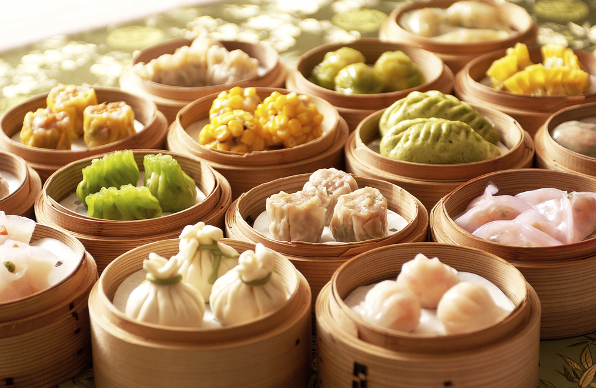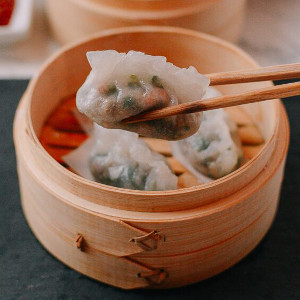I’ll admit it. I love Asian food and would eat it five nights a week or more if the rest of my family felt the same. Alas, they don’t. Nevertheless, we have agreed on one thing: Tuesday is ‘Dumpling Night’ at our house, when we celebrate the fun, flavourful tradition known as Dim Sum…
 Traditional Dim Sum selections: Note that a couple feature Spinach-tinted Wrappers.
Traditional Dim Sum selections: Note that a couple feature Spinach-tinted Wrappers.
It’s not unusual for restaurants which specialize in Dim Sum to have dozens of
different items on their menus, most variations on the traditional forms.
Last I heard, Sunday was still the traditional day of the week for Dim Sum – a feast of Dumplings, Bao, Shumai, Har Gao and Wontons served with an array of pungent dipping sauces.
But there’s a restaurant in my city’s Chinatown that serves DIm Sum every day, and they do it the right way. After being seated at your table with a blank order form at each place, servers begin to stop by with carts piled high with tiny Bamboo steamers, each filled with two or four items. If you say yes, they add the price of that order to your bill. You might be offered any or all of the aforementioned treats, with each steamerful priced at $4 to $6. It’s a little like Dumpling Roulette, but it’s a lot of fun to speculate on what you’ll be offered next. Basically, you just eat until you’re satiated and then ask a server to tote up the damage. I’ve eaten myself into a $25 tab at least once, with no trouble at all!
A Field Guide to Dim Sum
You should probably read up on the various kinds of Dim Sum treats before heading out to a restaurant for some for the first time – or to an Asian supermarket to get ready-0made frozen ones you can steam up at home. To simplify the process, I offer the following ‘pocket edition’ guide…
Dumplings are round pieces of Dumpling Pastry (a simple mixture of Wheat Flour and Water) about three in. / 8 cm in diameter stuffed with almost anything you can imagine or desire. The most common are minced meats such as Lamb, Pork, Beef, Chicken and Shrimp, often blended with Lee, Spinach or other traditional Asian veggies, finely chopped. A tablespoon full / 15 cc of filling is about right, placed smack in the middle of the pastry disc. Then fold over the pastry and crimp all around the open half-moon edge. Done. Now, repeat a few dozen more times.
Wontons are similar to Dumplings, but use a thinner Wonton wrapper.
Bao are little snow white pillows of Steam Bun Dough filled with any of a variety of flavours, usually BBQ Pork. Korean cuisine has a popular variant, which is made with the same ingredients (plus Kimchi, of course), but looks like a small Taco with a thick shell.
Har Gao are small white translucent Dumplings filled with Shrimp. They are distinguished from Bao and its kin by their wrappers, which use not only Wheat Flour, but Potato Flour, Tapioca or Cornstarch to achieve the transparency. They’re a little more complicated to make than other ‘wrapped’ Dim Sum treats, but are certain;y worth the extra work, in the end. Again, you can get these pre-made and frozen at most Asian supermarkets.
Shumai are little cylindrical meatballs of Shrimp, Pork, Beef, Lamb or Chicken wrapped bottom and sides with a distinctive, thin Lye Water Pastry. (You can use Wonton Wrappers for convenience.) Like Har Gao, these Meaty Mouthfuls are more complicated to make than regular Dumplings, but they’re worth the fuss!
Dipping Sauces?
The traditional Dipping Sauce for Dim Sum is a slightly Spicy Soy Sauce based concoction which can be purchased ready-made, at Any Asian supermsarket. I always have Sesame Oil, Light Soy Sauce, Hoisin Sauce and Oyster Flavour Sauce on hand for dipping. If you like it hot, try Thai Sweet Chili Sauce or Thai Spring Roll Sauce, straight up or blended with Sour Cream to cut the Spice a bit. That’s not traditional, but everybody I’ve tried it on likes it.
So, get yourself a Chinese steamer rig and experiment with Dim Sum. You’ll be glad you did!
~ Maggie J.

